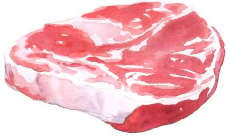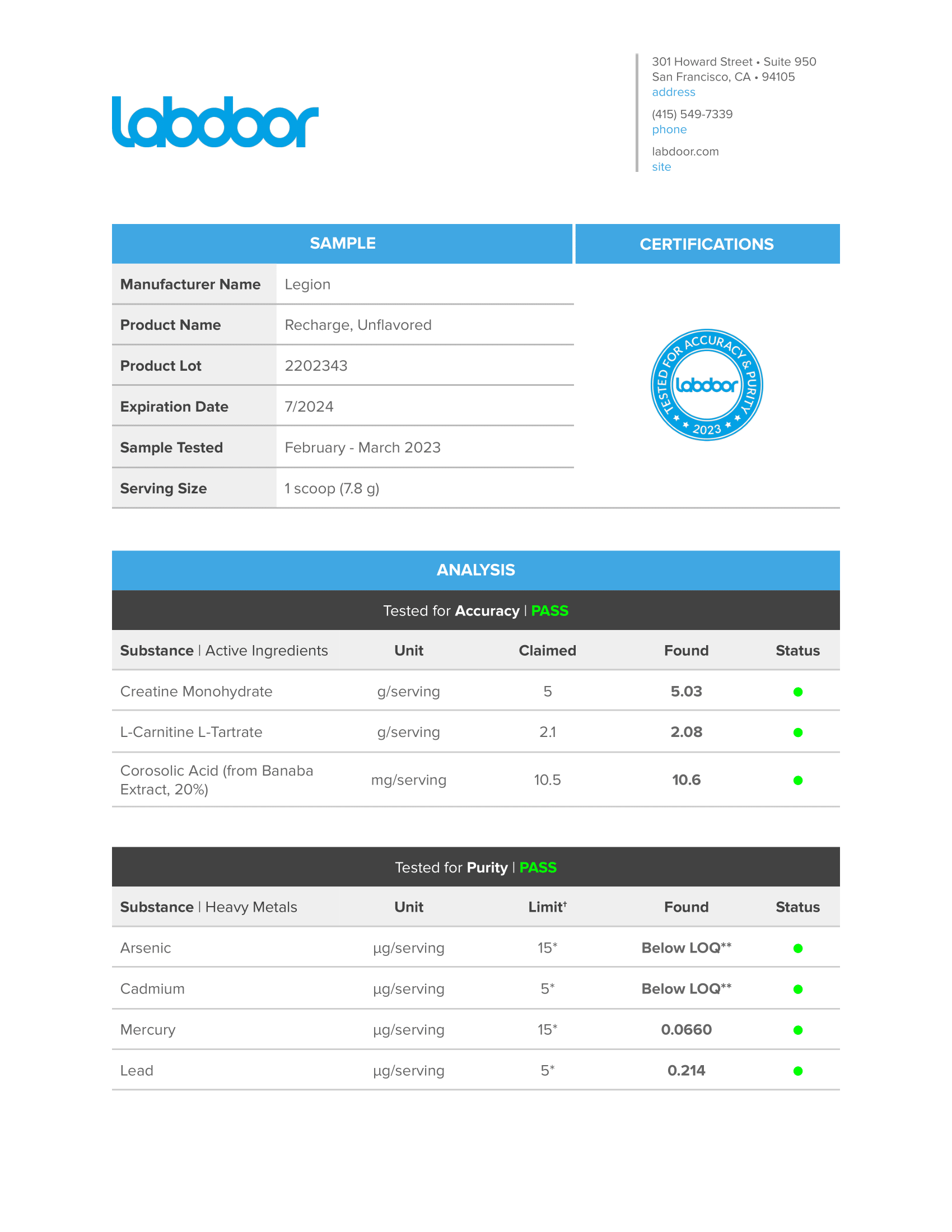If you don’t like something of ours, guess what happens next?
No, we don’t request you deliver it to a PO box in the Gobi Desert by carrier pigeon. Nor do we ask you to fill a cursed inkwell with orc’s blood and demon saliva and then use it to complete reams of return forms written in ancient Cyrillic script.
We just . . . wait for it . . . give you every penny of your money back. Holy moo cows. And that means you can say "yes" now and decide later.
Will Recharge help you pack on brain-shrinking amounts of muscle in 30 days flat?
No.
Will it add another plate or two to the bar?
Absolutely not.
But will Recharge help you train harder, recover better, and gain faster?
Yes. Or your money back.
- Tested for purity and potency in an ISO 17025-accredited third-party laboratory, and independently certified to contain no contaminants or banned substances by Labdoor™[7]
- Made in the USA with globally sourced ingredients in NSF-certified and FDA-inspected facilities that adhere to Current Good Manufacturing Practice standards
- Backed by our 100% Money-Back Guarantee that works like this: If you don’t absolutely love Recharge, just let us know, and we’ll give you a full refund on the spot. No forms or returns necessary.
So order now, try Recharge risk free, and see for yourself why it’s one of the most popular naturally sweetened and flavored post-workout supplements in the world (over 550,000 bottles sold and counting!).
Will Recharge help you pack on brain-shrinking amounts of muscle in 30 days flat?
No.
Will it add another plate or two to the bar?
Absolutely not.
But is Recharge a naturally sweetened and flavored[1] post-workout supplement with clinically effective doses[2] of 3 ingredients scientifically shown[3] to increase strength and power, improve muscle growth and recovery, and reduce muscle soreness?
And will it help you train harder, recover better, and gain faster?
Yes. Or your money back.
- 44 peer-reviewed scientific studies support the effectiveness of Recharge’s precise combination of ingredients, forms, and doses[4]
- Naturally sweetened and flavored with no artificial sweeteners, flavors, food dyes, fillers, or other unnecessary junk[5]
- No proprietary blends or hidden ingredients—each ingredient and dose are clearly listed on the label[6]
- Tested for purity and potency in an ISO 17025-accredited third-party laboratory, and independently certified to contain no contaminants or banned substances by Labdoor™[7]
- Made in the USA with globally sourced ingredients in NSF-certified and FDA-inspected facilities that adhere to Current Good Manufacturing Practice standards
Recharge is also backed by our 100% Money-Back Guarantee that works like this:
If you don’t absolutely love Recharge, just let us know, and we’ll give you a full refund on the spot. No forms or returns necessary.
So order now, try Recharge risk free, and see for yourself why it’s one of the most popular naturally sweetened and flavored post-workout supplements in the world (that has sold over 550,000 bottles and counting!).
Notice to California Consumers
WARNING: Consuming this product can expose you to chemicals including lead which is known to the State of California to cause cancer and birth defects or other reproductive harm. For more information go to www.P65Warnings.ca.gov/food.
Legion Recharge Ingredients (7.11 grams per serving)
Micronized Creatine Monohydrate (5 grams per serving)
Creatine is a compound made up of the amino acids L-arginine, glycine, and methionine. Our body can produce creatine naturally, but it can also absorb and store creatine found in various foods like meat, eggs, and fish.
Creatine monohydrate is creatine with one molecule of water attached to it. This form of creatine has been around (and studied) for decades and is a tried-and-true winner, whereas other forms have failed to produce better results.
The creatine monohydrate in Recharge has also been micronized, which is a process that produces very fine particles that are more water soluble and easier to digest. Thus, micronized creatine monohydrate mixes better with liquid than the non-micronized form and is less likely to upset sensitive stomachs.
Research shows that supplementation with creatine monohydrate . . .
- Boosts muscle and strength gain[8][9][10][11]
- Improves anaerobic endurance[12][13][14][15][16][17]
- Reduces muscle damage and soreness from exercise[18][19]
- Increases the amount of glycogen your muscles can store[20]
- Helps preserve lean mass and strength while restricting calories[21]
And in case you’re worried that creatine is bad for your kidneys, these claims have been horribly overblown.[22][23] Creatine supplementation isn’t advised in cases of kidney disease treated by diuretics, but in healthy people, both short- and long-term usage of creatine has no harmful side effects.[24][25][26]
The clinically effective dose of creatine monohydrate is 3 to 5 grams.[27]

L-Carnitine L-Tartrate (2.1 grams per serving)
L-carnitine is a naturally occurring amino acid found mostly in meat and dairy products. It’s “conditionally essential,” which means our body can produce it as long as we’re also eating enough of two other amino acids it can’t produce, lysine and methionine.
L-tartrate is a salt used to increase the absorption of other nutrients.
L-carnitine serves several vital functions in the body, mostly related to the production of cellular energy.[28] Thus, it’s not surprising that most of the L-carnitine in your body is found in your muscles, which have to be able to quickly generate a tremendous amount of energy.[29]
Additionally, when you supplement with L-carnitine, you greatly increase your body’s carnitine stores, and your muscles’ stores in particular.[30] This is why research shows that supplementation with L-carnitine L-tartrate . . .
The clinically effective dose of L-carnitine L-tartrate is 1 to 2 grams.[35]

Corosolic Acid (10.5 milligrams per serving)
Corosolic acid is a substance that comes from the leaves of the banaba plant, a tropical tree native to Southeast Asia.
Traditionally used in herbal medicine in the Philippines and other parts of Southeast Asia, corosolic acid inhibits the activity of an enzyme called PTB1B, which plays a vital role in regulating various cellular processes.
Research shows that supplementation with corosolic acid…
- Improves nutrition absorption
- Enhances antioxidant activity
- Supports healthy inflammation levels
- May improve body composition[36]
The clinically effective dose of corosolic acid is 10 milligrams.[37]

Naturally Sweetened and Flavored
While artificial sweeteners may not be as dangerous as some people claim, studies suggest that regular consumption of these chemicals may indeed be harmful to our health.[38][39][40][41][42][43]
That’s why we use natural sweeteners like stevia, erythritol, and monk fruit instead. Research shows that these ingredients are not only safe but can also confer several health benefits, including better nutrient absorption, healthy cholesterol and inflammation levels, and more.[44][45][46][47]

No Artificial Food Dyes, Fillers, or Other Unnecessary Junk
As with artificial sweeteners, studies show that artificial food dyes and fillers can cause negative effects in some people, including gastrointestinal toxicity and behavioral disorders.[48][49][50][51][52]
That’s why we use natural coloring and flavoring derived from fruits and other foods as well as naturally derived ingredients for improving texture, enhancing shelf life, and facilitating the manufacturing process.

Third-Party Lab Tested for Potency & Purity
Recharge is tested by a state-of-the-art ISO 17025-accredited third-party laboratory for heavy metals, microbes, allergens, and other contaminants to ensure compliance with FDA purity standards.



See how Legion Recharge compares to the rest.
- Clinically Effective Ingredients and Doses
- Creatine Monohydrate
- L-Carnitine
L-Tartrate - Corosolic Acid
- Naturally Sweetened
& Flavored - Third-Party Lab Tested
- Labdoor Certified Product
- Price Per Serving
-
Legion
Recharge
- 5 g
per serving - 2.1 g
per serving - 10.5 mg
per serving - $
-
Post JYM

- 2 g
per serving - $1.27
-
PEScience
TruCreatine+
- 5 g
per serving - N/A
- $0.67
-
Cellucor
M5 Ultimate
- 5 g
per serving - $1.99
The #1 brand of naturally sweetened and flavored sports supplements.
We’ve sold over 5 million bags and bottles to over 1 million customers in 169 countries who have left us over 55,000 5-star reviews.
Clinically Effective Ingredients and Doses
Every active ingredient, form, and dose in Recharge is backed by peer-reviewed scientific research demonstrating clear benefits in healthy humans.
Naturally Sweetened and Flavored
Recharge is naturally sweetened with stevia and naturally flavored with extracts from fruit, vegetables, plants and other foods.
Total Label Transparency
We clearly list the dose of each ingredient in Recharge on the label—no proprietary blends or hidden ingredients—so you can verify our formulation’s validity and effectiveness.
Third-Party Lab Tested by Labdoor™
Recharge is tested for purity and potency in an ISO 17025-accredited third-party laboratory, and independently certified to contain no contaminants or banned substances by Labdoor™.
Made in the USA
Recharge is made in America with globally sourced ingredients in NSF-certified, FDA-inspected facilities that adhere to Current Good Manufacturing Practice (cGMP) standards.
100% Money-Back Guarantee
If you don't absolutely love Recharge, you get a prompt and courteous refund. No forms or returns necessary.
Trusted by scientists, doctors, and everyday fitness folk alike.
Frequently Asked Questions
+References
While artificial sweeteners may not be as dangerous as some people claim, studies suggest that regular consumption of these chemicals may indeed be harmful to our health. That’s why we use the natural sweeteners stevia and monk fruit instead. ↑
Every serving of Recharge contains 7.1 grams of active ingredients that have been shown to be safe and effective in peer-reviewed scientific research. ↑
Each active ingredient in Recharge is backed by published scientific studies that show benefits in healthy humans. ↑
That’s 486 pages of scientific research that shows Recharge works exactly like we say it does. ↑
While artificial sweeteners may not be as dangerous as some people claim, studies suggest that regular consumption of these chemicals may indeed be harmful to our health. That’s why we use the natural sweeteners stevia and monk fruit instead. ↑
Every bottle of Recharge is guaranteed to provide exactly what the label claims and nothing else—no heavy metals, microbes, allergens, or other contaminants. ↑
This means you know exactly what’s in every serving of Recharge—every dose of every ingredient—and can verify the accuracy and efficacy of the formulation. ↑
Branch JD. Int J Sport Nutr Exerc Metab. 2003 Jun;13(2):198-226. doi: 10.1123/ijsnem.13.2.198. ↑
Hoffman J, Ratamess N, Kang J, Mangine G, Faigenbaum A, Stout J. Int J Sport Nutr Exerc Metab. 2006 Aug;16(4):430-46. doi: 10.1123/ijsnem.16.4.430. ↑
Law YL, Ong WS, GillianYap TL, Lim SC, Von Chia E. J Strength Cond Res. 2009 May;23(3):906-14. doi: 10.1519/JSC.0b013e3181a06c59. ↑
Rawson ES, Volek JS. J Strength Cond Res. 2003 Nov;17(4):822-31. doi: 10.1519/1533-4287(2003)017<0822:eocsar>2.0.co;2. ↑
Eckerson JM, Stout JR, Moore GA, Stone NJ, Iwan KA, Gebauer AN, Ginsberg R. J Strength Cond Res. 2005 Nov;19(4):756-63. doi: 10.1519/R-16924.1. ↑
Mero AA, Keskinen KL, Malvela MT, Sallinen JM. J Strength Cond Res. 2004 May;18(2):306-10. doi: 10.1519/R-12912.1. ↑
Eckerson JM, Stout JR, Moore GA, Stone NJ, Nishimura K, Tamura K. J Strength Cond Res. 2004 Feb;18(1):168-73. doi: 10.1519/1533-4287(2004)018<0168:eotafd>2.0.co;2. ↑
Koçak S, Karli U. J Sports Med Phys Fitness. 2003 Dec;43(4):488-92. ↑
Kendall KL, Smith AE, Graef JL, Fukuda DH, Moon JR, Beck TW, Cramer JT, Stout JR. J Strength Cond Res. 2009 Sep;23(6):1663-9. doi: 10.1519/JSC.0b013e3181b1fd1f. ↑
Fukuda DH, Smith AE, Kendall KL, Dwyer TR, Kerksick CM, Beck TW, Cramer JT, Stout JR. J Strength Cond Res. 2010 Jul;24(7):1826-33. doi: 10.1519/JSC.0b013e3181e06d0e. ↑
Bassit RA, Pinheiro CH, Vitzel KF, Sproesser AJ, Silveira LR, Curi R. Eur J Appl Physiol. 2010 Mar;108(5):945-55. doi: 10.1007/s00421-009-1305-1. Epub 2009 Dec 3. ↑
Santos RV, Bassit RA, Caperuto EC, Costa Rosa LF. Life Sci. 2004 Sep 3;75(16):1917-24. doi: 10.1016/j.lfs.2003.11.036. ↑
Nelson AG, Arnall DA, Kokkonen J, Day R, Evans J. Med Sci Sports Exerc. 2001 Jul;33(7):1096-100. doi: 10.1097/00005768-200107000-00005. ↑
Rockwell JA, Rankin JW, Toderico B. Med Sci Sports Exerc. 2001 Jan;33(1):61-8. doi: 10.1097/00005768-200101000-00011. ↑
Poortmans JR, Francaux M. Sports Med. 2000 Sep;30(3):155-70. doi: 10.2165/00007256-200030030-00002. ↑
Terjung RL, Clarkson P, Eichner ER, Greenhaff PL, Hespel PJ, Israel RG, Kraemer WJ, Meyer RA, Spriet LL, Tarnopolsky MA, Wagenmakers AJ, Williams MH. Med Sci Sports Exerc. 2000 Mar;32(3):706-17. doi: 10.1097/00005768-200003000-00024. ↑
Yoshizumi WM, Tsourounis C. J Herb Pharmacother. 2004;4(1):1-7. ↑
Bizzarini E, De Angelis L. J Sports Med Phys Fitness. 2004 Dec;44(4):411-6. ↑
Groeneveld GJ, Beijer C, Veldink JH, Kalmijn S, Wokke JH, van den Berg LH. Int J Sports Med. 2005 May;26(4):307-13. doi: 10.1055/s-2004-817917. ↑
Bemben MG, Lamont HS. Sports Med. 2005;35(2):107-25. doi: 10.2165/00007256-200535020-00002. ↑
Pekala J, Patkowska-Sokoła B, Bodkowski R, Jamroz D, Nowakowski P, Lochyński S, Librowski T. Curr Drug Metab. 2011 Sep;12(7):667-78. doi: 10.2174/138920011796504536. ↑
Evans AM, Fornasini G. Clin Pharmacokinet. 2003;42(11):941-67. doi: 10.2165/00003088-200342110-00002. ↑
Wall BT, Stephens FB, Constantin-Teodosiu D, Marimuthu K, Macdonald IA, Greenhaff PL. J Physiol. 2011 Feb 15;589(Pt 4):963-73. doi: 10.1113/jphysiol.2010.201343. Epub 2011 Jan 4. ↑
Kraemer WJ, Volek JS, French DN, Rubin MR, Sharman MJ, Gómez AL, Ratamess NA, Newton RU, Jemiolo B, Craig BW, Häkkinen K. J Strength Cond Res. 2003 Aug;17(3):455-62. doi: 10.1519/1533-4287(2003)017<0455:teolls>2.0.co;2. ↑
Volek JS, Kraemer WJ, Rubin MR, Gómez AL, Ratamess NA, Gaynor P. Am J Physiol Endocrinol Metab. 2002 Feb;282(2):E474-82. doi: 10.1152/ajpendo.00277.2001. ↑
Ho JY, Kraemer WJ, Volek JS, Fragala MS, Thomas GA, Dunn-Lewis C, Coday M, Häkkinen K, Maresh CM. Metabolism. 2010 Aug;59(8):1190-9. doi: 10.1016/j.metabol.2009.11.012. ↑
Ho JY, Kraemer WJ, Volek JS, Fragala MS, Thomas GA, Dunn-Lewis C, Coday M, Häkkinen K, Maresh CM. Metabolism. 2010 Aug;59(8):1190-9. doi: 10.1016/j.metabol.2009.11.012. ↑
Spiering BA, Kraemer WJ, Vingren JL, Hatfield DL, Fragala MS, Ho JY, Maresh CM, Anderson JM, Volek JS. J Strength Cond Res. 2007 Feb;21(1):259-64. doi: 10.1519/00124278-200702000-00046. ↑
Stohs SJ, Kaats GR, Preuss HG. Phytother Res. 2016;30(4):681-688. doi:10.1002/ptr.5577. ↑
Fukushima M, Matsuyama F, Ueda N, Egawa K, Takemoto J, Kajimoto Y, Yonaha N, Miura T, Kaneko T, Nishi Y, Mitsui R, Fujita Y, Yamada Y, Seino Y. Diabetes Res Clin Pract. 2006 Aug;73(2):174-7. doi: 10.1016/j.diabres.2006.01.010. ↑
Abou-Donia MB, El-Masry EM, Abdel-Rahman AA, McLendon RE, Schiffman SS. J Toxicol Environ Health A. 2008;71(21):1415-1429. doi:10.1080/15287390802328630.↑
Qin X. Department of Surgery, University of Medicine and Dentistry of New Jersey, New Jersey Medical School, Newark, New Jersey, USA. Can J Gastroenterol. 2011 Sep;25(9):511. doi:10.1155/2011/451036 ↑
Schernhammer ES, Bertrand KA, Birmann BM, Sampson L, Willett WC, Feskanich D. [published correction appears in Am J Clin Nutr. 2013 Aug;98(2):512]. Am J Clin Nutr. 2012;96(6):1419-1428. doi:10.3945/ajcn.111.030833↑
Fowler SP, Williams K, Resendez RG, Hunt KJ, Hazuda HP, Stern MP. Obesity (Silver Spring). 2008;16(8):1894-1900. doi:10.1038/oby.2008.284↑
Sylvetsky A, Rother KI, Brown R.. Pediatr Clin North Am. 2011;58(6):1467-xi. doi:10.1016/j.pcl.2011.09.007↑
Yang Q. Neuroscience 2010. Yale J Biol Med. 2010;83(2):101-108.↑
Yadav SK, Guleria P. CSIR-Institute of Himalayan Bioresource Technology, Palampur, 176061, HP, India. Crit Rev Food Sci Nutr. 2012;52(11):988-98. ↑
Shivanna N, Naika M, Khanum F, Kaul VK. Department of Applied Nutrition, Defence Food Research Laboratory, Mysore, India. J Diabetes Complications. 2013 Mar-Apr;27(2):103-13. ↑
World Health Organization. WHO Press; 2006. Available at: http://whqlibdoc.who.int/publications/2006/9241660546_eng.pdf. Accessed January 24, 2019. ↑
Ozbayer C, Kurt H, Kalender S, Ozden H, Gunes HV, Basaran A, Cakmak EA, Civi K, Kalender Y, Degirmenci I. Department of Medical Biology, Faculty of Medicine, Eskisehir Osmangazi University, Eskisehir, Turkey. J Med Food. 2011 Oct;14(10):1215-22. ↑
Feng J, Cerniglia CE, Chen H. Division of Microbiology, National Center for Toxicological Research, US Food and Drug Administration, AR , USA. Front Biosci (Elite Ed). 2012 Jan 1;4:568-86. ↑
Kanarek RB. Department of Psychology, Tufts University, Medford, Massachusetts, USA. Nutr Rev. 2011 Jul;69(7):385-91. ↑
Nigg JT, Lewis K, Edinger T, Falk M. Oregon Health and Science University, Portland, OR, USA. J Am Acad Child Adolesc Psychiatry. 2012 Jan;51(1):86-97.e8. ↑
McCann D, Barrett A, Cooper A, Crumpler D, Dalen L, Grimshaw K, Kitchin E, Lok K, Porteous L, Prince E, Sonuga-Barke E, Warner JO, Stevenson J. School of Psychology, Department of Child Health, University of Southampton, Southampton, UK. Lancet. 2007 Nov 3;370(9598):1560-7. ↑
Gao Y, Li C, Shen J, Yin H, An X, Jin H. Scientific and Technological College of Chemistry and Biology, Yantai Univ., Yantai, PR China. J Food Sci. 2011 Aug;76(6):T125-9. ↑
























